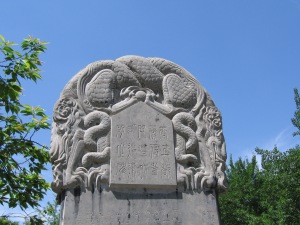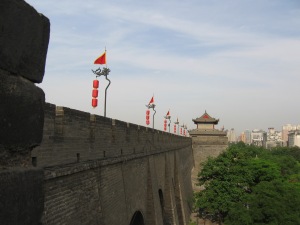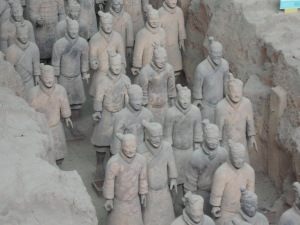I travelled by air from Guilin to Xi’an in central northern China. Xi’an airport is around 35 kilometres from the city, but as the traffic can be very unpredictable in the urban area, the journey to the city may take a long time. For example, my journeys to and from the airport by road each took over an hour – and the return trip to the airport was nearer to 90 minutes.
Xi’an is a city of around 8 million people and it is rich in craft and history. Before Beijing was declared the capital of unified China, Xi’an was the capital of northern China. During this period it hosted 13 dynasties including Zhou, Qin, Han, Sui, and Tang and saw the reign of 72 Emperors.
Xi’an marks the eastern starting/ending point of the ancient Silk Road. The first contacts between Indian Buddhists and the Chinese people happened along the Silk Road during the Eastern Han dynasty (from 8-220AD) and Xi’an became a major access point for Buddhism to enter China. Two famous and important Buddhist pagodas erected in the Tang Dynasty about 1300 years ago are in Xi’an.
The “Big Wild Goose Pagoda” was built to honour the Chinese Buddhist monk, Xuan Zang (sometimes known as “Monkey”). He became a monk at eleven years old, but grew disillusioned with the Buddhist writings available in China so when he was 26 he headed west along the Silk Road to the base of Buddhism, India.
After extensive travels, he returned to China 17 years later and wrote a detailed description of this in his “Record of the Western Regions”. He wrote much up to date information about Central Asia which Chinese authorities found very valuable. Accordingly, the Emperor authorized a translation of these Sanskrit texts and arranged construction of the Indian design pagoda to store them securely.
Five kilometres away is the “Little Wild Goose Pagoda”. Originally 15 storeys tall, a huge earthquake hit in 1556 and reduced the pagoda to 13 storeys, which still stand. The earthquake caused a major crack down the entire pagoda and the two top tiers fell. The crack was repaired, but the two storeys were never replaced and the remaining 13-storeys have withstood all earthquakes since.
When you visit, you can take a staircase inside the pagoda to get to the top to see it. Also inside is a museum of precious Xi’an relics of jade, seals, statues, stone carvings, porcelains, calligraphies and paintings. The gardens surrounding the Little Pagoda are beautiful, there is a Bell Tower here and it was lovely to see several wedding parties having their photographs taken in the grounds. It is a beautiful pocket of peace in Xi’an.
Xi’an boasts its own magnificent City Wall. The Wall was originally built to fortify the settlement during the Tang dynasty (618 -907) but after the establishment of the Ming dynasty, the Emperor enlarged it and created the modern Wall.
It’s the most complete city wall to survive in China and is one of the largest ancient military defensive systems in the world. The wall is 12 meters (40 feet) tall, 14 meters (46 feet) wide at the top and 18 meters (60 feet) thick at the bottom. It is 14 kilometres (8 miles) long and every 120 meters there is a rampart with a sentry building for soldiers to use in defence
In terms of local cuisine, I recognised a regional difference between northern and southern China. I had just been in southern areas where the diet comprised mainly of vegetable based dishes with some protein, accompanied by rice. However, in northern China the local cuisine seems more likely to be spicier protein based dishes with some vegetables accompanied by noodles or dumplings. In fact, Xi’an people may boast the dumpling as a famous delicacy of their area! The change in cuisine was quite delightful and I enjoyed several very lovely meals here.
My main reason to visit Xi’an was to see the famous Terracotta Warriors. At the tender age of 13, Qin Shi Huang was made King of the state of Qin and by the time he was 38 he had conquered the six neighbouring states to unify China for the first time – he was made Emperor. It was while he was still a young teenager that he planned protection for his afterlife – he designed his tomb with defences including an army of thousands of life-size solders to protect him.
The army was to be made of terracotta and comprised of infantrymen, archers, officers, generals, horses and chariots. At the time, ancient craftsmen were able to make the thousands of free-standing statues, each with a hollow head and arms, but with solid legs. Each had dress specific to their rank and featured eyes, mouth, nose, ears, beard and armour. The members of the army viewable today represent only a small portion of the thousands of statues still buried at the ancient site outside Xi’an.
The Terracotta Warrior exhibition is about an hour’s drive out of Xi’an. Three giant “pits” display excavations of the army at the various stages they have reached. The important archaeological site was discovered in 1974 by Farmer Wang, the occupier of the farm land, when he was digging for water after a long drought. He dug down 4 metres and struck one of the statues.
During his reign, Qin introduced many significant innovations for China – a common script, a measurement and monetary system, a legal system, a central administrative system (government), agricultural reforms and construction of many roads. He also supervised construction of a northern defence fortification, the first Great Wall of China. It is also believed that Qin had a deep distrust of women, since his mother had betrayed him years before – and that it is for this reason he never married, but kept over 10,000 concubines. It is also thought to be the reason that no females are depicted in the Terracotta Army, only males.
In the pits, all the statues face East – because that is the direction Qin expected his enemy to appear from. A visitor can spend several hours here looking at the exhibitions because there is a lot to see – but also because there will probably be a lot of other people there to see the very special army as well. You will need to be aware that apart from the buildings housing the pits and exhibitions, there is very little shade here. The car park is several hundred metres from the pit sites and you may find yourself out in the hot sun for long periods of the day.
Apart from tourism, Xi’an also has three other major industries – aircraft manufacturing, textiles and lacquer work. A huge local aeronautical factory employs over 100,000 people. The lacquer industry is very strong here. You will probably recognise this work as the very dark, almost black, timber fashioned into furniture (tables, desks, side-boards, screens etc), sometimes also inlaid with mother-of-pearl or other decorative material, then coated with several layers of high-gloss lacquer. The result is a very highly polished and beautiful piece, usually very dark in colour (like rosewood or mahogany) with a deep, almost impenetrable, long lasting shining surface. At the Xi’an Art & Ceramics Lacquer Exhibition, I watched staff working on manual production of the terra-cotta statues (which looked like very hard work indeed). The production takes over a week because the clay is first moulded into shape by hand, then fired at 300 degrees Celsius (570 degrees Fahrenheit) for three days, then fired at 900 degrees Celsius (1,600 degrees Fahrenheit) for a further seven days, which means that although the material is still just pottery, it is now as hard as steel.
At the Exhibition you can also view a fine selection of lacquer furniture (for sale). I bought a beautiful nest of three lacquer tables for a very reasonable price. The service was outstanding here – the merchant was very happy to arrange shipping of my articles back to Australia at a reasonable charge and I am happy to say it arrived within two months, securely and very well packaged. I highly recommend them. The lacquer industry is strong in this region because the city is surrounded by mountains with forests of lacquer trees. These are accessible and able to be milled for use. I also believe that the lacquer forests in this region supported the wild panda population for several centuries, but these have largely been hunted out now and a wild panda is a rare sight.
A very strong Muslim community is established here and as a result Xi’an is the site of The Great Mosque. This is located in the centre of the city and is the largest and one of the most important Islamic places of worship in China. Construction of the mosque began in 742 AD during the Tang Dynasty. Additions were made during the Song, Yuan, Ming and Qing dynasties, so the mosque architecture represents many periods of time. You may enjoy a visit to the mosque and also the fascinating Muslim markets nearby.
I really enjoyed my visit to Xi’an – it is a fascinating, beautiful and very welcoming place which I would love to visit again given the chance.







